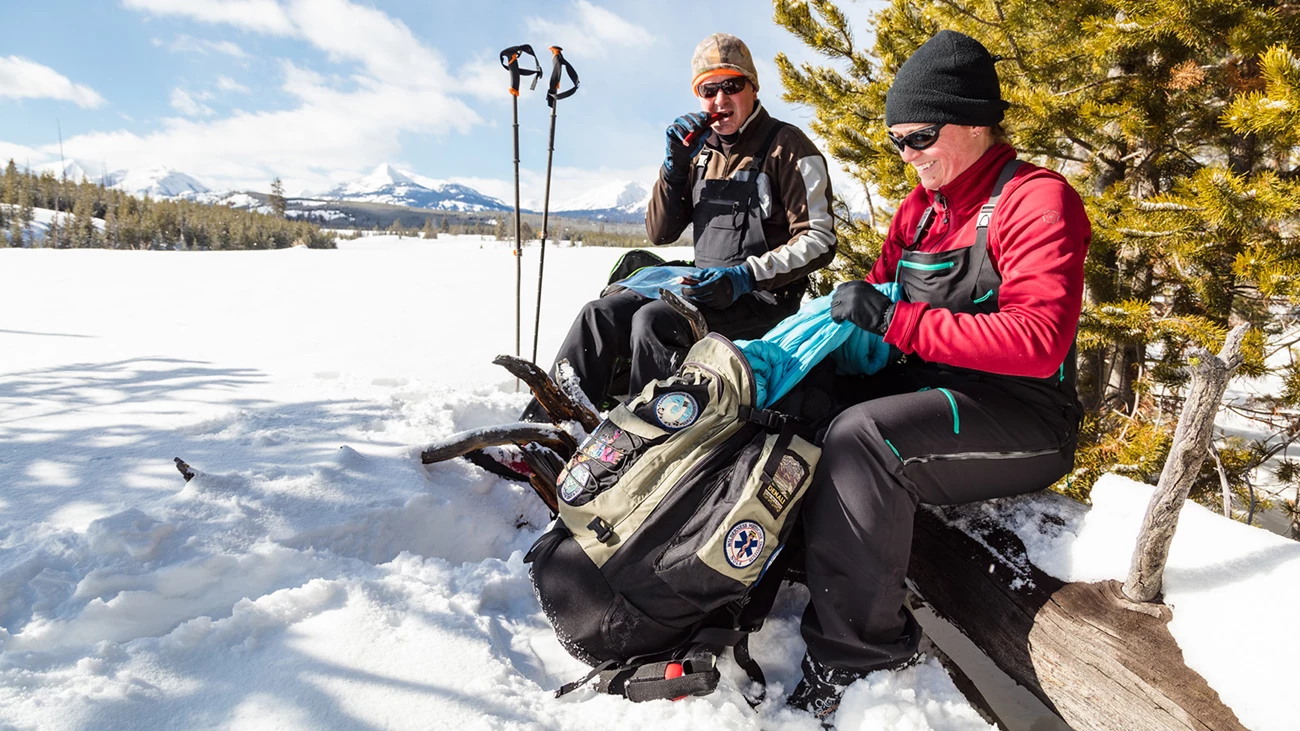
For anyone willing to brave the cold, winter in Yellowstone offers rewards and challenges, with landscapes and temperatures that will take your breath away. Highs approach 30°F (-1°C) during the day, while lows can drop to -30°F (-34°C) at night. If you plan to venture out, prepare for cold air, deep snow, and slippery boardwalks. And give some thought to what happens if things don't go as planned: when you're stuck outside as temperatures drop, you need to be more prepared than normal. Food & DrinkYellowstone’s altitude—6,000 feet (1829 m) above sea level or higher—and cold, dry winter air can cause dehydration. Make sure to carry and drink plenty of water (in insulated bottles so it doesn’t freeze). Some warming huts offer water or other cold drinks. Carry high energy snacks as well: the harder your body works to keep warm, the more you need to eat and drink. What to WearWinter in Yellowstone is severe, but with proper clothing, you can stay safe and comfortable. Dress in adjustable layers to prevent both overheating and chilling. Wear a windproof, hooded outer layer with insulating wool or synthetic garments underneath. Avoid cotton—it won’t keep you warm when wet. For deep snow, use synthetic or wool pants with long underwear and add wind or rain pants for extra warmth. Keep feet dry with wool socks, gaiters, and insulated boots. Wear gloves or wool mittens with breathable shells. Since most heat escapes through your head, use a balaclava or hood for maximum protection. Sunglasses are essential—snow reflects intense sunlight, increasing the risk of snow blindness. Apply sunscreen to exposed skin. Traction AidsSnow-packed roads and boardwalks can be slippery, especially near thermal areas. People fall and hurt themselves a lot. Keep your footing by wearing traction aids over your shoes or boots. DrivingWinter in Yellowstone offers a more remote experience than in summer, which means that help may not be close if you get into trouble. Winter drivers face a number of hazards, including black ice, snow-packed roads, and whiteouts. Drive times can be significantly longer in bad conditions. Drive carefully and only use plowed pullouts so that you can spend your time in the park watching wildlife instead of waiting for a tow truck (which may take hours to reach you). Check our road status map before you leave (most roads are closed during winter), and make sure you have the proper winter safety equipment for your car: snow tires, a flashlight (and extra batteries), a first aid kit, a blanket or sleeping bag, booster cables, maps, and a shovel. Skiing & SnowshoeingWhether on a groomed trail or in the backcountry, you are in a wilderness environment with inherent risks—unpredictable wildlife, shifting weather, hydrothermal areas, deep snow, open streams, and avalanches. For off-trail cross-country skiing, use touring or mountaineering skis and boots. Avoid narrow racing skis and low shoes, as they lack the support needed for rugged conditions. The right gear can make or break your trip. SnowmobilingPeople can explore Yellowstone’s on a snowmobile by hiring a guide or applying for a non-commercial permit. Snowmobiles must remain on groomed roads and obey all posted speed limits. Guided trips will ensure you have all the gear needed for a safe outing. If you'll be traveling on your own, we recommend carrying a shovel, avalanche beacons, a map, a spare drive belt, a basic tool kit or multi-tool, a first aid kit, a flashlight (and extra batteries), sunglasses, handwarmers, and a winter survival kit....in addition to adequate clothing, food, and water. Check our road status map before you leave since weather occasionally closes roads to snowmobiles. AvalanchesAvalanches occur throughout the Yellowstone area and can be deadly. Learn how to recognize and avoid avalanche-prone terrain. The following websites offer safety information and local avalanche forecasts:
During winter, the road over Sylvan Pass may close temporarily due to avalanche danger and during avalanche control work. View the current status of park roads.
|
Last updated: April 29, 2025



